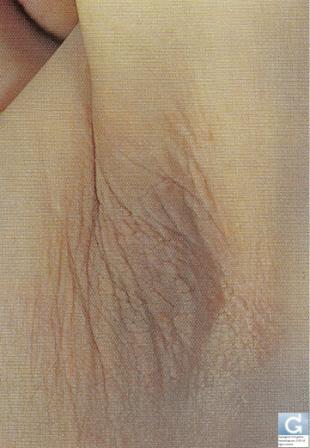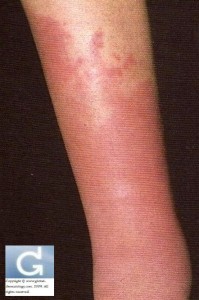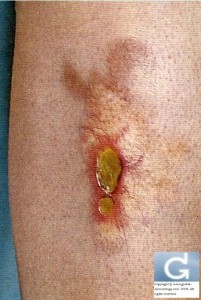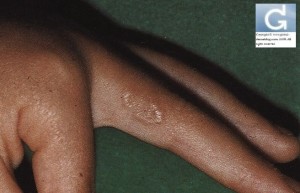Tabagisme et peau
Dr Christophe Hsu – dermatologue. Genève, Suisse
Qu’est-ce que le diabète?
- Le diabète est une maladie fréquente chez la population adulte dans les pays développés.
- Les personnes diabétiques ont des taux élevés de sucre dans le sang et si cela n’est pas bien contrôlé, des organes variés comme les yeux, les reins, le système nerveux central et les vaisseaux sanguins peuvent être endommagés.
- Les problèmes de peau sont fréquents chez les diabétiques. Certaines maladies de peau sont caractéristiques.
Quelles sont les maladies de peau fréquemment associées au diabète ?
- Dermopathie diabétique
- C’est la maladie de peau la plus fréquente chez les diabétiques.
- Les lésions sont souvent localisées en regard des tibias et se présentent comme des cicatrices brunes. Les cicatrices brunes peuvent être précédées par des taches rouges ou des bulles (=cloques).
- Il n’y a pas de traitement spécifique de cette affection. Le problème tend à guérir par lui-même pour former des cicatrices déprimées.
- Gangrène
- Le blocage de grands vaisseaux dans les pieds à cause du diabète peut produire des douleurs à la marche en raison de la mauvaise circulation. Une occlusion sévère peut aboutir à la gangrène des doigts de pied à cause de la mort tissulaire.
- Un traitement chirurgical est nécessaire pour enlever le tissu mort et dans les cas sévère, une amputation du pied ou de la jambe peut être nécessaire.
- Neuropathie diabétique
- Le diabète peut endommager les nerfs par l’occlusion des vaisseaux sanguins les nourrissant.
- Ceci peut produire des douleurs et des fourmillements, voire une abolition des sens dans les pieds. Les patients ont également alors une abolition de la sensation de douleur ce qui peut aboutir au développement de blessures ou d’ulcères à la suite de traumatismes.
- Il faut alors effectuer des soins locaux des lésions pour que le problème ne s’aggrave pas.
- Infections de la peau
- Les diabétiques développent plus facilement des infections de la peau. Des exemples sont des infections des poils, superficiels ou profonds.
- Certaines infections sont sérieuses et requirent une prise en charge médicale rapide, un exemple sont les furoncles multiples, qui sont des infections bactériennes profondes (=abcès) du poil.
- Une dermohypodermite se présente comme une tuméfaction rouge chaude et douloureuse souvent localisée sur la jambe.
- La fascéite nécrosante est une infection grave et mortelle qui peut s’étendre en profondeur atteignant le muscle, qui nécessite un traitement chirurgical immédiat.
- Elle se présente comme une tuméfaction enflammée et hémorragique de la peau qui forme des bulles.
- Nécrobiose Lipoïdique
- C’est une complication rare du diabète, provoquée également à cause d’une maladie des petits vaisseaux de la peau.
- Les lésions apparaissent en premier généralement sur la région des tibias. La peau affectée à une bordure rouge brune avec un centre jaunâtre.
- Parfois les lésions sur la peau précèdent le diagnostic du diabète et donc les patients ayant cette affection devraient être dépistées pour le diabète.
- Acanthosis nigricans
- C’est une autre manifestation du diabète sur la peau.
- C’est également le signe d’autres maladies internes comme des maladies endocrinologiques et le cancer interne. Il se retrouve souvent chez les personnes ayant une surcharge pondérale.
- Les lésions cutanées sont caractérisées par un aspect « comme du velours » et rugueux des plis cutanés, comme les aisselles, le haut du dos, le cou et la région des plis au niveau des organes génitaux.

Acanthosis Nigricans
- Xanthomes et Xanthélesma
- Les personnes diabétiques ont souvent une élévation des graisses dans le sang (triglycérides et cholesterol). Ceci provoque une accumulation de graisses dans la peau. Les lésions induites s’appèlent xanthomes et/ou xanthélesma.
- Les xanthomes sont des nodules cutanés fermes autrement asymptomatiques qui sont distribués sur les coudes, genoux et talons. Parfois, les lésions sont de la taille d’une tête d’épingle, et apparaissent sur les fesses (xanthomes éruptifs).
- Les Xanthélasma signent un excès de cholestérol dans le sang et se présentent comme des lésions jaunâtres sur les paupières. Le traitement consiste à normaliser le niveau des graisses, soit par un contrôle alimentaire de la prise de lipides saturés, soit par des médicaments en comprimés.
- Granulome annulaire
- C’est une maladie de peau retrouvée généralement chez les enfants et les jeunes adultes.
- Elle est occasionnellement associée avec le diabète.
- Les lésions sont caractérisées par des taches rouges initialement qui s’étendent ensuite de manière centrifuge pour ressembler à des bagues. Les mains, surtout les doigts ainsi que les coudes sont souvent affectés.
- Quand le granulome annulaire est étendu, il peut être associe à un diabète. Les lésions sur la peau peuvent précéder le diagnostic de diabète, donc les personnes présentant avec ces lésions devraient être dépistées pour le diabète.
Que faire si j’ai des lésions de la peau associées au diabète ?
- Quand il y a des complications graves comme des infections bactériennes ou la gangrène, consultez un médecin immédiatement.
- Dans ces cas là, une hospitalisation peut être nécessaire.
- Si ces maladies ne sont pas traitées, elles peuvent évoluer vers la mort. Les ulcères infectés doivent être traités par des antibiotiques.
Est-ce que ces complications graves du diabète peuvent être prévenues ?
- Oui. Si votre diabète est bien contrôlé, beaucoup de problèmes cutanés lies au diabète peuvent être évités.
- Cela requiert de la discipline, un régime diabétique, des médicaments des contrôles par soi-même et chez le médecin.
- Les soins “skin care” de pied et de la peau sont importants:
- Ne marchez pas pieds nus. Ceci est afin d’éviter les traumatismes.
- Inspectez vos pieds tous les jours à la recherche de coupures ou de plaies. Inspectez l’espace entre vos doigts de pied à la recherche d’une inflammation ou d’une infection.
- Mettez des souliers bien ajustés qui ne sont pas trop serrés ou trop grands, afin d’éviter des traumatismes.
- Faites attention lorsque vous vous coupez les ongles.
- Si des plaies ou des ulcères se développent, consultez un médecin sans délai. Certains signes sur la peau sont aussi l’indication que d’autres complications pourraient affecter d’autres organes du corps comme les yeux et les reins. Votre médecin recherchera ces complications.
Contributeurs
Dr Christophe Hsu – dermatologue. Genève, Suisse.
National Skin Centre. Singapour
Português Italiano Tagalog Español Deutsch 日本語 中文-漢語 русский язык
Related posts



